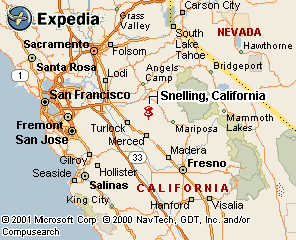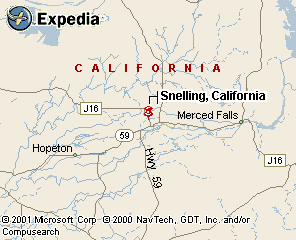|
|
Canku Ota |
|
|
(Many Paths) |
||
|
An Online Newsletter Celebrating Native America |
||
|
November 3, 2001 - Issue 48 |
||
|
|
||
|
Spirituality of Salmon |
||
|
by Melanie Turner-Modesto Bee-October 27, 2001 |
||
|
Photo: By Ted Benson-Third-graders from Christine Sipherd School in Modesto who visited the Merced River Fish Hatchery near Snelling for the start of salmon spawning season hold on to a handful of salmon eggs. |
 SNELLING --
Each year at about this time, salmon return here. For the past three spawning seasons, so have members of a Mewuk
tribe. SNELLING --
Each year at about this time, salmon return here. For the past three spawning seasons, so have members of a Mewuk
tribe.And ever since the American Indians started giving thanks for the salmon run on the Merced River, the fish count has been climbing. "We feel they know it and more will come up (the river)," said Mewuk spiritual leader Jay Johnson of Mariposa. "The more we have prayers and ceremonies, we feel we're going to have a good year." This year's spawning season began Friday on a warm fall day at the state fish hatchery here. About 20 Indians, mostly Mewuk, came together for a ceremony on a small, weedy peninsula across from the spawning house. They sang and prayed in celebration of the return of the salmon, offering a male and female fish to a fire to thank them for swimming upstream. They also thanked the creator for acorns, pine nuts and berries growing this time of year. Next to the fire lay a small pile of tobacco, medicinal herbs and a basket. The items were given as offerings to the fish. Beginning with four elder women, one by one each adult around the fire responded to Mewuk Bill Tucker's request to give offerings. Giving thanks for the bounty Tucker walked around the circle, waving a burning stick of mugwart, used much like incense in a church. Each person pinched tobacco from an oyster shell and sprinkled it on the fire. Dorothy Maczko, 74, of Mariposa said she gave thanks for being here, for the salmon and for "all our elders." "What's so special about the salmon (is) it provides the winter fat so people can sustain themselves," American Indian Ron Wermuth said. "It's the last fresh food that comes this late in the season." For whatever reason, more salmon came back from 1999 through last year. State personnel capture the fish and harvest their sperm and eggs, put them together for fertilization, and then nurture the eggs through the hatching process. Eventually the salmon fry are put in the river to continue the salmon's life cycle. Hatchery keeps process thriving Hatchery personnel retrieved 1.2 million eggs from 304 fish in 1998, 1.8 million eggs from 375 fish in 1999 and 5.3 million eggs from 937 fish last year. The hatchery is one reason for the better numbers, said Mike Cozart, who has managed the Merced facility for the state Department of Fish and Game since 1984. He said the hatchery collects more eggs than the salmon would normally deposit in the river, and the hatchery's fertility rate is 85 percent to 95 percent. The fertility rate in the wild is 10 percent to 15 percent. Cozart recently suffered a stroke, and he came from a hospital in a wheelchair to be at the hatchery to celebrate another spawning season. No one was celebrating 10 years ago, when drought cut the salmon count to its lowest point in at least 20 years. The hatchery captured nine females in 1991, and harvested only 48,000 eggs. In recent years there has been more water, and people have worked along the Merced River to create better conditions for natural spawning. Every year since 1990, the state has deposited 1,000 tons of gravel into the river near the hatchery, creating more places for salmon to spawn, said Kevin Faulkenberry of the Department of Water Resources. Four months ago, construction began on the second leg of a five-mile river restoration project along the Merced above the Highway 59 bridge. The planning process began two years ago, and the Indians conducted a blessing then. The ceremony coincided with the start of the spawning season, said Wermuth, who administers the project. The ancient tradition spawned a new tradition that day along the Merced. Said Johnson: "In our way, that's the right way." |
|
|
|
|
Merced Salmon |
|
|
|
||
|
|
||
| Canku Ota is a free Newsletter celebrating Native America, its traditions and accomplishments . We do not provide subscriber or visitor names to anyone. Some articles presented in Canku Ota may contain copyright material. We have received appropriate permissions for republishing any articles. Material appearing here is distributed without profit or monetary gain to those who have expressed an interest. This is in accordance with Title 17 U.S.C. section 107. | ||
|
Canku Ota is a copyright © 2000, 2001 of Vicki Lockard and Paul Barry. |
||
|
|
|
|
|
The "Canku Ota - A Newsletter Celebrating Native America" web site and its design is the |
||
|
Copyright © 1999, 2000, 2001 of Paul C. Barry. |
||
|
All Rights Reserved. |
||


